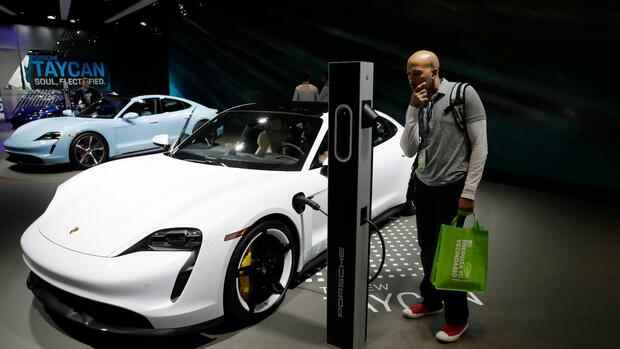A Porsche Taycan charging at the auto show in Los Angeles: the battery-powered vehicle will also be the rule at the Stuttgart sports car manufacturer, the e-fuels an exception.
(Photo: AP)
Dusseldorf It sounds like a magic formula: With e-fuels produced in a climate-friendly manner, cars with internal combustion engines could still be on the road for many years to come without polluting the environment. Porsche is therefore building a pilot plant in the south of Chile, which is intended to demonstrate precisely this supposed future viability of e-fuels.
Unfortunately, it doesn’t work out that way. The essential component of e-fuels is hydrogen, which Porsche also produces in Chile with the help of wind energy. However, it would be a shame to use this elaborately produced hydrogen in a car. Green hydrogen produced in a climate-friendly manner is needed much more urgently elsewhere.
Airplanes, ships, large trucks – hydrogen is much better off there. A great deal of green hydrogen will also be required in industry over the next few decades – for example in chemistry for the production of fertilizers. Or in the steel industry, which is to produce much cleaner in the future with the help of hydrogen.
Cars are small enough to be equipped with a real alternative: the purely battery-powered electric motor. However, this is hardly possible in an airplane or in a ship, as they are much too big. The batteries that would be needed for this would be huge and far too heavy. That is the main reason that green hydrogen should be used for this above all.
Top jobs of the day
Find the best jobs now and
be notified by email.
But there is something else that speaks in favor of electric drive by battery: energy efficiency. More than 80 percent of the electricity that drives an electric car is converted into kinetic energy. It couldn’t be much better. In terms of energy efficiency, the electric drive also beats the diesel and gasoline engines used today by far.
An energy devourer
The production of green hydrogen also consumes a lot of energy. Only 30 to 40 percent of the amount of energy used ends up in driving a car. This is another reason why hydrogen should be used where batteries cannot be used – i.e. in ships, airplanes, trucks and in large-scale industry.
At the end of the day, the Porsche facility in Chile is likely to be reserved for a very manageable customer group: the drivers of the iconic 911 sports car, who want to be on the road with it even after the age of the combustion engine has come to an end. Hydrogen produced in a climate-friendly way will be a very scarce commodity for a long time to come. In case of doubt, state regulation must ensure that hydrogen is used where it is most likely to be needed – and that is not in private cars.
More: E-fuels from Chile: How Porsche wants to save the 911
